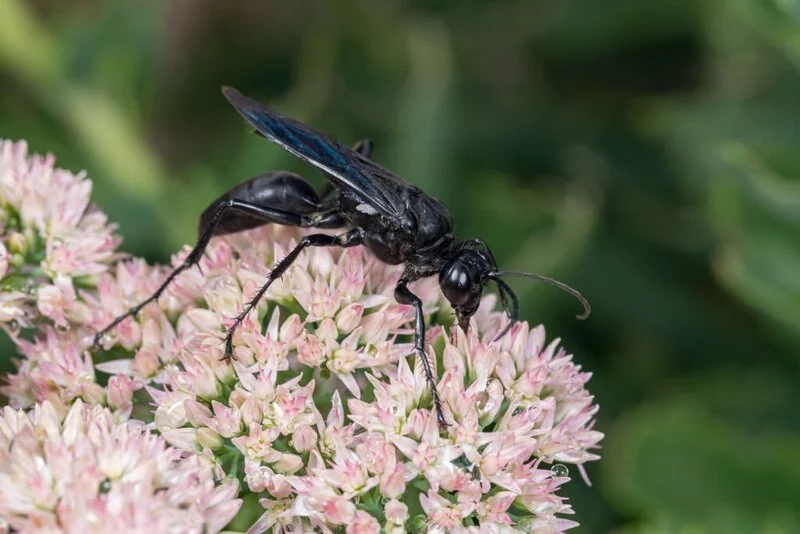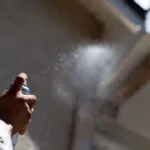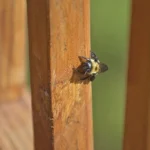Welcome to our guide on dealing with an intriguing but potentially troublesome visitor – the Great Black Wasp. These creatures, while beneficial to gardens due to their pollination activity, can also pose challenges, especially when their populations increase or if they choose to nest too close to our homes. Our goal here is to help you understand these wasps better and provide you with simple, effective methods to control their presence, ensuring a peaceful coexistence.
- Eliminate Wasps – Our exclusive VisiLure technology lures wasps, red wasps, mud daubers, and carpenter bees with appealing colors and a multi-dimensional pattern. Once attracted, they become stuck to the sticky surface and expire.
- Visual Attractant – The targeted insects are naturally lured to the trap without odors, chemicals, or wasp sprays. It catches queens and workers, from spring through fall.
- Thoughtful Design – Our unique Glue Guards create a barrier around the sticky trap surface to reduce the chances of non-insect catches.
- Prevent Damage – Mud daubers (mud wasps, dirt daubers) and carpenter bees can cause serious property damage. Our TrapStik can stop this before it starts, without the use of potentially harmful sprays or chemicals.
- Made in the USA – At RESCUE!, our goal is to design, manufacture, and market the safest and most effective pest control solutions available for homeowners. We are proud to manufacture our products in the USA!
Great Black Wasp
The Great Black Wasp, known scientifically as Sphex pensylvanicus, is an impressive insect. Noted for its size – up to 1.5 inches long – and striking glossy black color, it’s a species that’s hard to miss. Unlike some of its stinging relatives, the Great Black Wasp is solitary, meaning it lives and breeds alone rather than in large colonies. They are also known as digger wasps because of their habit of burrowing in sandy soil to lay their eggs. Understanding this behavior is the first step to managing them.
Why and When to Control Great Black Wasps
While Great Black Wasps are generally non-aggressive towards humans unless provoked, their presence can become a problem when they start nesting in areas where people frequent, posing a risk of accidental encounters. More so, if you or a family member is allergic to wasp stings, the stakes are even higher.
The best time to control the Great Black Wasp population is in the early summer when they start their nesting activities. At this time, you can watch for their distinctive flying patterns and the typical mounds of soil that indicate a nearby burrow. Early intervention can help manage their numbers before they become a significant problem.
Tools and Materials Needed for Great Black Wasp Control
Controlling Great Black Wasps doesn’t require a lot of complicated tools or equipment. The primary things you’ll need are:
- Protective Clothing: To avoid accidental stings, wear long pants, a long-sleeved shirt, gloves, and even a hat with a net to cover your face.
- Wasp Trap: You can find these at any gardening store. They are safe and effective for catching wasps.
- Diatomaceous Earth: This natural substance can be used to treat the entrance of wasp nests. It is a powdery substance that can be harmful to wasps but is safe for humans and pets.
- Natural Product – Composed of 4lbs of 100% ground freshwater diatomaceous earth with absolutely no additives or fillers.
- OMRI Listed – Listed with the Organic Minerals Research Institute, a non-profit organization that reviews products against organic standards.
- Powder Duster Included – Powder duster in the bag for easy and efficient application of diatomaceous earth on animal feed
- Supports a Great Cause – Harris donates 10% of profits to support the local Etowah Valley Humane Society.
- Made in the USA – Mined in Nevada and packaged in Georgia
Step-by-Step Guide to Get Rid of Great Black Wasps
- Identify the Nests: The first step is to find where the wasps are nesting. Look for small mounds of soil with a hole in the middle. Remember, these wasps are solitary, so each nest usually houses just one wasp and her eggs.
- Apply Diatomaceous Earth: Once you’ve found the nests, carefully apply the diatomaceous earth around the entrance. The wasps will carry it into the nest on their bodies, which will eventually kill them and their larvae.
- Set Up Wasp Traps: Set up the wasp traps in areas where you have observed wasp activity. The traps lure the wasps in, and then they cannot escape.
Remember, always carry out these activities in the evening or early morning when the wasps are less active.
Preventive Measures Against Great Black Wasps
- Regularly Inspect Your Yard: Stay on the lookout for signs of wasp activity, especially in the early summer when they begin their nesting.
- Maintain Your Garden: Keep your garden clean and free from debris, which can serve as potential nesting sites for these wasps.
- Seek Professional Help if Needed: If you’re uncomfortable dealing with wasps or if the infestation is too large, don’t hesitate to contact a pest control professional.
Remember, wasps play a crucial role in our ecosystems, so our goal should always be to manage their populations responsibly rather than aiming for total eradication.
Frequently Asked Questions about Great Black Wasps
Are Great Black Wasps Dangerous?
While their appearance might be intimidating, Great Black Wasps are not typically aggressive towards humans. They can sting, but usually only do so when threatened or provoked.
Do Great Black Wasps Help the Garden?
Absolutely! They’re pollinators, and their hunting helps to control pest populations. However, too many wasps can become a nuisance, especially if you have a fear of stinging insects.
Can I Prevent Great Black Wasps from Nesting?
While it’s tough to completely prevent them, maintaining a clean garden and early detection of nests can go a long way in managing their populations.
Conclusion
Managing Great Black Wasps can be a delicate balance, as they’re beneficial to our ecosystem. However, if their presence becomes overwhelming or their nests are in areas with high human activity, it’s time to take action. The most important things are to stay safe, wear protective clothing, and remember that you can always seek professional help if needed. Your garden should be a place of peace and enjoyment – you’ve got the tools and knowledge now to ensure it stays that way, wasps or no wasps!






